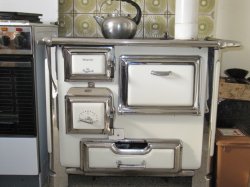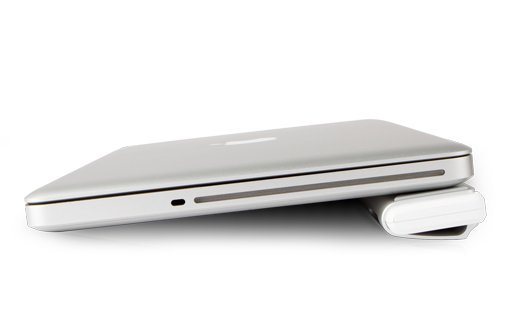So adding more to the mix; If you are concerned about temperature and want to reduce it elevation of the rear of the machine helps, as sitting flat on the desk only reflects the heat back to the base of the Mac. You can buy passive aluminium coolers like Rain Designs Mstand or iLap. Most powered coolers are designed for PC notebooks and don't work overly well with Mac`s if at all. One cooler that does work efficiently is the Moshi Zefyr 2, as it`s principle of cooling is specifically designed for Apple portables, by blowing the air horizontally across the base of the computer, however don't expect miracles.
Link:
Moshi Zefyr 2
A cheap USB fan can achieve the same if strategically placed, not as elegant mind, nor as easy to put in your notebooks case

but they do help to reduce case temperatures.
You can use software to override Apple`s own cooling algorithm by manually taking control of fan RPM and setting up power profile presets with SMC Fan Control 2.4, or here with
UltraFan which allows you stipulate a preset temperature and the software will automatically raise and lower fan RPM`s to keep the system at the predefined temp, which i personally feel is a far more elegant solution. At the end of the day you want to control your system temperature, not your fan rpm`s. For me SMC is now pretty much redundant with the latest release of UltraFan having manual control of the fans RPM, and subsequently i am starting to uninstall it from my own Mac`s. SMC FC is a great app, however although it`s recently updated, functionality is limited compared to some newer apps, equally SMC Fan Control is rock steady stable and a finished product.
Strictly speaking Apple`s own cooling algorithm works, albeit at sacrifice of increased temps for quieter operation. This has always been the Apple way and is really nothing detrimental to the system, i have one MBP from 2008 all original barring a recent fan change that has an uptime of over 30K hours. The latest MBP`s need less assistance in remaining cool; for some it`s simply disconcerting the heat generated and transferred to the case, although it`s perfectly normal as the aluminium acts as a heat-sync. i have to deal with elevated ambient temperature so at times a software solution is useful. Apart from the passive cooling the Mstands bring they also offer a very sound ergonomic solution. A passive cooler and UltraFan will maximise the cooling, there is little else you can do short of reducing the ambient temperature or the system load. If I know i am going to push a system i will close all apps that are not essential as this can and does make an impact to system temperature.
High temperatures in general is not overly harmful to your systems, what is far more detrimental is thermal stress, where temperatures rapidly fluctuate by significant margins over a short period of time. Anyone striving for great longevity should look to minimise rapid temperature changes, here UltraFan is your best friend.
Using a RainDesign Mstand, a Moshi Zefyr 2 and latest version of UltraFan I can reduce temperature by over 20C when transcoding an MKV video file, and that is something worth thinking about;
- Apple default cooling algorithm 99C - 103C (still on Mstand) fans 4K and escalating

- Mstand, Zefyr & UltraFan 79C - 82C fans at 5.8K

Recently i have been experimenting with a CoolerMaster Notrepal E1 cooling pad, it has a single very large fan 23CM (9") running at 800 rpm, and most importantly moving a significant 91.25 CFM, this is far more than most other powered coolers i have tried.
The fan by far takes up the majority of the coolers body, runs slow and quiet.
As it`s designed for a PC portable i didn't have any high expectations; the cooler runs quiet as in silent, perfect size for a 15" MBP, has USB expansion, single speed with on/off button and lifts the machine a good couple of inch`s of the desk. I chose my Late 2011 2.4 i7 15" MBP, it`s connected to an external display, runs 24/7 and is generally north of 70C (158F) on any given day. Any software solution only results in the MBP doing a fair impression of a "Turbojet" which we all love to loath, as workloads rise and temperatures increase.
The important part cooling; well as ever with a Mac a mixed bag, the elevation definitely helps versus being flat on the desk. I have little expectation of any cooler reducing a Mac`s internal temperature significantly, what the Notepal E1 was able to do was systematically reduce fan rpm by a good 1K without any increase in internal temperatures, which is a big step forward. With this cooler and a software solution (UltraFan/SMC Fan Control) it`s possible to have a moderate load and a relatively quiet system, and that counts for a lot. The major downside to the Notepal E1 is the size, it`s clearly designed to be "planted" on the desk. when using the 10 degree angle i use a piece of that rubber you can buy for car dashboards, just to ensure the MBP doesn't slip and slide about, just seems prudent with such an expensive notebook perched on the edge of the desk. The Notepal E1 also unusually blows a stream of cool air out of the front to cool the hands which is well unusual, nevertheless not unpleasant on a hot day.
I still rate the Moshi Zefyr 2 as the best powered cooler for a Mac portable simply due to it`s continuous horizontal air flow, however the pricing and availability make it a tough choice. 1K reduction in fan speed may not sound that big a deal, however if that keeps the Mac below the "Turbojet' threshold then it`s a worthwhile investment for anyone seeking the quieter life

The downside of the Moshi cooler is it`s very pricy at around $80, however it`s by far the best portable solution if that`s what you need. What i have observed over the years is the best solution is a combination of software, and powered cooler, on my Late 2011 15" MBP (2.4 i7) running both internal & external display`s i run; Ultrafan set to 66C, AdBlock and it sits on a CoolerMaster NotePal E1 this results in a reasonably cool and quiet system. My Retina is better behaved thermally and i just run UltraFan, AdBlock and it sits on a Rain Design Mstand.
Note: the CoolerMaster Notepal E1 moves a very considerable volume of air, over 91 cubic feet per minute (CFM) a regular PC cooler moving say 40 - 60 CFM will have little to no effect on an Apple portable. My recent observations are undertaken in an ambient temperature of 25C to 28C, so you may not need to go all the way to achieve a cool, quiet Mac
The old adage still applies; it`s easier to keep a system cool, than cool-down an already hot machine, or more literally "sooner rather than later". This being said it`s not strictly necessary, equally it`s nice to know that there are options for reducing temperature out there.









